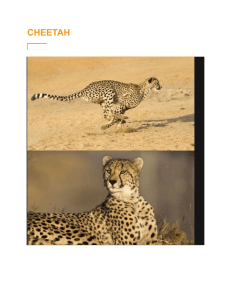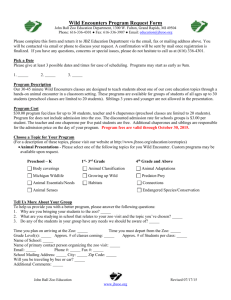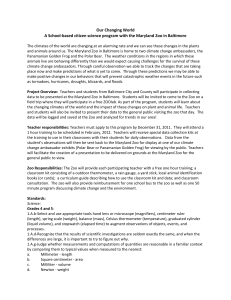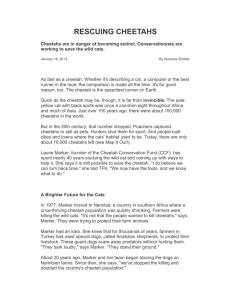The Maryland Zoo in Baltimore Zone 3: Leopard, Cheetah, Gazelle
advertisement
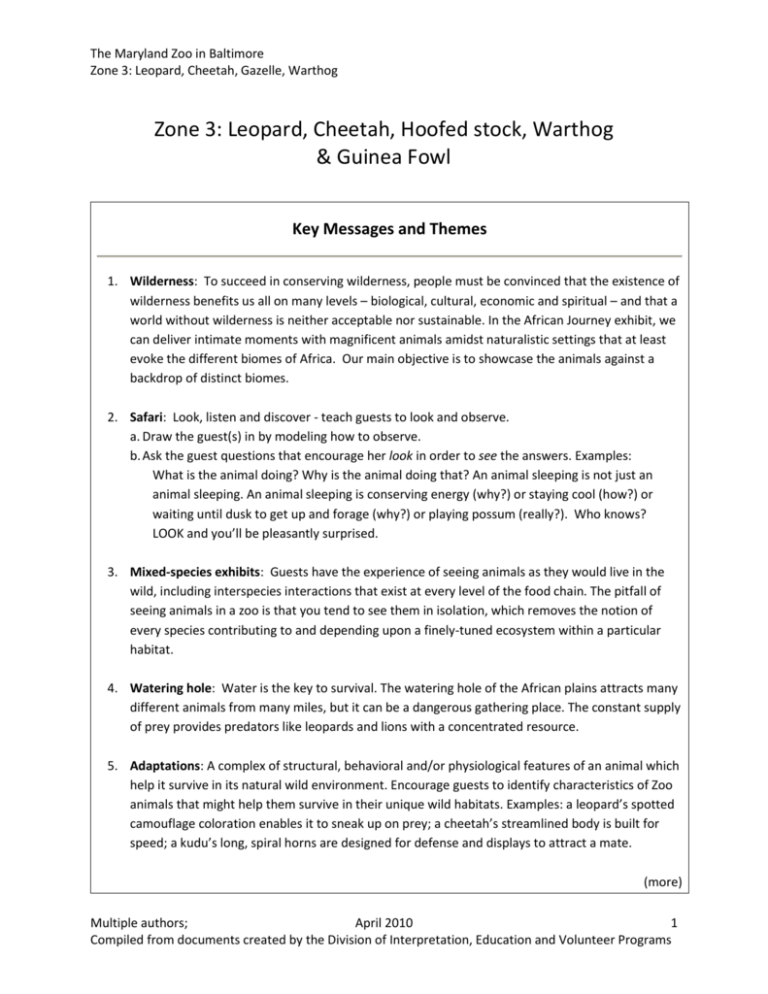
The Maryland Zoo in Baltimore Zone 3: Leopard, Cheetah, Gazelle, Warthog Zone 3: Leopard, Cheetah, Hoofed stock, Warthog & Guinea Fowl Key Messages and Themes 1. Wilderness: To succeed in conserving wilderness, people must be convinced that the existence of wilderness benefits us all on many levels – biological, cultural, economic and spiritual – and that a world without wilderness is neither acceptable nor sustainable. In the African Journey exhibit, we can deliver intimate moments with magnificent animals amidst naturalistic settings that at least evoke the different biomes of Africa. Our main objective is to showcase the animals against a backdrop of distinct biomes. 2. Safari: Look, listen and discover - teach guests to look and observe. a. Draw the guest(s) in by modeling how to observe. b. Ask the guest questions that encourage her look in order to see the answers. Examples: What is the animal doing? Why is the animal doing that? An animal sleeping is not just an animal sleeping. An animal sleeping is conserving energy (why?) or staying cool (how?) or waiting until dusk to get up and forage (why?) or playing possum (really?). Who knows? LOOK and you’ll be pleasantly surprised. 3. Mixed-species exhibits: Guests have the experience of seeing animals as they would live in the wild, including interspecies interactions that exist at every level of the food chain. The pitfall of seeing animals in a zoo is that you tend to see them in isolation, which removes the notion of every species contributing to and depending upon a finely-tuned ecosystem within a particular habitat. 4. Watering hole: Water is the key to survival. The watering hole of the African plains attracts many different animals from many miles, but it can be a dangerous gathering place. The constant supply of prey provides predators like leopards and lions with a concentrated resource. 5. Adaptations: A complex of structural, behavioral and/or physiological features of an animal which help it survive in its natural wild environment. Encourage guests to identify characteristics of Zoo animals that might help them survive in their unique wild habitats. Examples: a leopard’s spotted camouflage coloration enables it to sneak up on prey; a cheetah’s streamlined body is built for speed; a kudu’s long, spiral horns are designed for defense and displays to attract a mate. (more) Multiple authors; April 2010 1 Compiled from documents created by the Division of Interpretation, Education and Volunteer Programs The Maryland Zoo in Baltimore Zone 3: Leopard, Cheetah, Gazelle, Warthog Key Messages and Themes (contd.) 6. Status: The conservation status of species in the Zoo’s collection is determined by the IUCN (World Conservation Union) Red List of Threatened Species. This list provides taxonomic, conservation status and distribution information on taxa that have been globally evaluated using the IUCN Red List Categories and Criteria. This system is designed to determine the relative risk of extinction, and the main purpose of the IUCN Red List is to catalogue and highlight those taxa that are facing a higher risk of global extinction (i.e. those listed as Critically Endangered, Endangered and Vulnerable). The IUCN Red List also includes information on taxa that are categorized as Extinct or Extinct in the Wild; on taxa that cannot be evaluated because of insufficient information (i.e. are Data Deficient); and on taxa that are either close to meeting the threatened thresholds or that would be threatened were it not for an ongoing taxon-specific conservation program (i.e. are Near Threatened). Taxa that have been evaluated to have a low risk of extinction are classified as Least Concern. You can find Maryland Zoo species status listings on signage throughout the Zoo, as well as within these Zone Interpretation documents. See the IUCN Red List website for more information: http://www.iucnredlist.org/ 7. Training: Training is an important component of animal care for nearly every species at the Zoo. More than anything else, it provides a means for keepers and animals to communicate effectively, so that many husbandry and management activities can be done in a relaxed and efficient way. Training also challenges animals mentally, which is good enrichment. According to Mike McClure, General Curator, our philosophy and objective at The Maryland Zoo is that “every animal that can be trained is trained for husbandry.” The formal training program used at the Zoo is based on operant conditioning that rewards an animal for demonstrating desired natural behaviors on cue. At the outset of training, if an animal performs a desired behavior on cue, it is rewarded with a food treat or verbal praise or something else pleasant. A bridging stimulus, such as a click from a hand-held clicker, is given just after the behavior is performed in order to associate the behavior with the reward. In time, and depending on the animal being trained and the behavior being requested, the bridging stimulus may become positive reinforcement enough for the animal and the reward (food treat) can be omitted. Training tends to be oriented toward specific husbandry goals. For example, target training (to shift animals), scale training (to collect weights regularly), blood draws (for medical exams), body presentations (for regular examinations). (more) Multiple authors; April 2010 2 Compiled from documents created by the Division of Interpretation, Education and Volunteer Programs The Maryland Zoo in Baltimore Zone 3: Leopard, Cheetah, Gazelle, Warthog Key Messages and Themes (contd.) 8. Enrichment Overview: In the wild, animals keep busy mentally and physically searching for food and avoiding predators. In a zoo, animals don’t have to do either. Being challenged both physically and mentally, though, is absolutely essential to the wellbeing of any animal. That is why enrichment is a crucial part of animal care at The Maryland Zoo. Enrichment refers to anything -- an object or an experience – that elicits natural behaviors and stimulates interaction with the environment. New objects to investigate, an unexpected change to the environment, scent stimulation, hidden food, and behavioral training are all forms of animal enrichment at the Zoo. A toy that simply acts to distract an animal is not true enrichment. So, for example, there is a tremendous difference between a big red rubber ball (which would qualify simply as a toy) and a big red rubber ball covered with the urine of a female in estrus (which would qualify as enrichment). Mike McClure, the Zoo’s General Curator, also stresses that enrichment should provide choices. When given choices, animals are more challenged, more in control, and more content. Long-term, Mike and Julie Grove, who oversees the Zoo’s Training and Enrichment Programs, plan to shift animal enrichment at the Zoo toward more naturalistic forms. This means that guests will see fewer “toys” and other non-naturalistic objects (all of which Mike refers to as “exhibit furniture”) in exhibits. It also means that guests may not be as aware when animals are interacting with enrichment, because the forms of enrichment will be more subtle and naturalistic (such as scent stimulation). Interpreters can help guests to understand and appreciate enrichment by pointing out and describing natural behaviors that the animals may be demonstrating, and suggesting how these behaviors can be solicited through enrichment. For the time being, though, guests are still likely to see boomer balls and cardboard boxes and other non-naturalistic items in exhibits because the shift in focus will be gradual. Julie encourages keepers to think of enrichment as one of their most important responsibilities, and an essential part of their day, not just a “fun extra.” To provide proper enrichment, she explains, keepers have to know the natural history of the animals in their care. They need to know what natural behaviors could be elicited, and then get creative about how to elicit them. So, for example, you would not put meat in a bag for an animal that does not rip into its food. You would design the enrichment around how that animal feeds. The Animal Department has a process for approving all enrichment items and an evaluation process to determine the value of each item. Keepers also have frequency goals to follow depending on the species. Primates may require 3 to 5 enrichment items a day (food and non-food), but the tortoises may only need 3 per week. Object enrichment is effective, if done properly. Objects need to be rotated often, and novel objects introduced regularly. Enrichment can also mean changing a perch, adding a random feeding to an animal’s day, covering a log in a new scent, or having a training session. (more) Multiple authors; April 2010 3 Compiled from documents created by the Division of Interpretation, Education and Volunteer Programs The Maryland Zoo in Baltimore Zone 3: Leopard, Cheetah, Gazelle, Warthog Reasons for providing animals with enrichment: Mental and physical stimulation for the animal Behavioral occupation Prevent/combat undesirable behaviors Educational value for Zoo guests It is required by the USDA and the AZA! Methods of enrichment: “Bait” exhibit – enrichment items are strategically placed in the exhibit during the morning routine before animals are given access to the enclosure. This method allows items to be more accurately placed and encourages investigative behaviors. Like any enrichment idea it can become old and routine, but does reward animals shifting between holding areas. Training session – causes animals to think and move in ways that they may not otherwise. Spontaneous rewards – Timing is essential when providing animals with enrichment items during the day. Items should not be offered unless the behavior occurring is worthy of reinforcement. Keeper/guest interaction – personal contact and possible feeding allows animals to interact with people they know well or that they have never met before. Some species desire this more than others and comfort level and safety must be analyzed. Multiple authors; April 2010 4 Compiled from documents created by the Division of Interpretation, Education and Volunteer Programs The Maryland Zoo in Baltimore Zone 3: Leopard, Cheetah, Gazelle, Warthog Species within Zone 3 African Leopard Natural History Characteristics o Long, muscular body; broad paws; short ears o Flower-shaped spots on backs called rosettes, with a solid edge and no dot in the center o White spots on the tip of their tails and back of their ears help leopards locate and communicate with each other in tall grass o Great athletes, able to run in bursts up to 36 mph (58 km per hour), leap 20 ft (6 m) forward in a single bound, and jump ten ft (3 m) straight up o Strong swimmers; one of the few cats that like water Status: Stable Habitat: Savanna, woodlands, tropical forest Diet: Carnivore: other mammals, birds, arthropods Active: Nocturnal Life Span: Captive: 11-13 yrs; Wild: 7-9 yrs Reproduction/Offspring: 1-3 young per litter Length: 40-75 in (100-190 cm) Weight: 66-155 lb (30-70 kg) Social Structure: Solitary but have been seen in groups of 3-4 Adaptations o Camouflage coloration: spot pattern helps them hide from their prey, breaking up their outline in forests or grassland o Famous for ability to go undetected. Leopards use their acute vision and keen hearing while hunting, not their sense of smell. They stalk and pounce but don’t usually chase their prey long distances. They grab their prey or swat it, using their retractable claws. Prey is killed with a bite to the throat. o Strong, agile climbers; can descend from a tree head-first. Can climb as high as 50 ft (15 m) up a tree holding a dead animal in its mouth, even one larger and heavier than itself. They stash food up high so other predators like lions or hyenas can’t get to it. o Eyes located in the front of the skull (typical of predators) provide depth perception and accurate distance judgment, which makes them excellent hunters of prey animals Training: o Both will target, sit, stand up along training door, present paws and hip to mesh, follow keeper, go from point A to B and open mouths. o We are working towards o Injection training o Climbing tree behavior Individual History Amari: Female, born 1993 Hobbes: Male, born 1994 Multiple authors; April 2010 5 Compiled from documents created by the Division of Interpretation, Education and Volunteer Programs The Maryland Zoo in Baltimore Zone 3: Leopard, Cheetah, Gazelle, Warthog Cheetah Natural History Characteristics o Long and lanky bodies that resemble greyhounds (slim with long legs) and are uniquely designed to run very fast for fairly short distances, allowing them to catch prey that other big cats can’t get o Coat is marked by round or oval black spots measuring .75 to 1.5 inches in diameter and is coarse with the hair slightly longer at the nape than elsewhere o The last third of the tail is marked by four to six black rings and a bushy white tuft at the very end. The tail rings are distinctive on each cheetah and enable individual identification o Small heads with short ears, high set eyes and a black line which looks like a tear drop running from the inner aspect of each eye down to the mouth o Slight sexual dimorphism: males are larger Status: Vulnerable Habitat: Savannas, semi-desert, open grasslands, thick bush, dry forest Diet: Carnivore: small to medium sized ungulates, birds, hares, small mammals Active: Diurnal Life Span: Captive: up to 19 yrs; Wild: 10-16 yrs Reproduction/Offspring: 1-8 per litter Length: 44-59 in (112-150 cm) Weight: 77-158 lb (35-72 kg) Social Structure: Solitary except at breeding time Adaptations o Cheetahs are the sprinters of the cat world and are the fastest terrestrial mammal. A flexible spine allows their front legs to stretch far forward on each stride. While running, they cover 20 to 22 feet (6 to 6.7 m) in one stride and can run at speeds of up to 70 mph (112 km ph). This top speed can only be maintained for roughly 275 m. o Cheetahs are off the ground more than half of their running time. Their semi-retractable claws are hard and sharp like cleats, giving them great traction when they run. o Cheetahs have smaller teeth and larger nasal passages than other big cats, an adaptation that allows them to take in more air during the recovery period after a sprint. o Cheetahs must eat quickly, as they can be driven off by leopards, lions, or hyenas. They aren’t strong enough to hide or guard their catch, so they have only one chance to eat their meal. They must kill more often, expending more energy than other big cats. o Cheetahs are quite vocal, making a unique, bird-like sound called a “chirrup” when they’re excited. Mothers use the same sound to call their cubs. They also purr, growl, snarl, hiss, cough, moan, and bleat, but cheetahs cannot roar like lions or tigers do. During mating season, cheetahs make a unique sound called a “stutter bark.” (more) Multiple authors; April 2010 6 Compiled from documents created by the Division of Interpretation, Education and Volunteer Programs The Maryland Zoo in Baltimore Zone 3: Leopard, Cheetah, Gazelle, Warthog Cheetah (contd.) Natural History (contd.) Conservation Issues The cheetah is in danger of becoming extinct. Humans are largely responsible for the cheetah’s endangered status and humans can be responsible for its return from the brink. Creative solutions can allow for human beings to coexist successfully with the cheetah and so many other endangered species. The problem There are approximately 12,500 cheetahs left in the wild today, down from as many as 100,000 just 100 years ago. The largest concentration of cheetahs – 20% of the total wild population – lives in Namibia. Human pressures are largely responsible for the cheetah’s endangered status. The combination of poaching, habitat encroachment (so that cheetahs are competing with stronger predators for less prey in a smaller geographic range than ever before), and extermination by farmers are overwhelming the ability of the species to adapt and survive. Should problem be solved? Humans can and should make this commitment not only to the cheetah but to other endangered species because long-term the planet’s biodiversity is at stake. In a conflict over space or natural resources between humans and animals, there is no need for one “winner.” There is a need for humans to come up with creative solutions that allow us to peacefully coexist with animal species while still attending to our own survival needs. Solution for the cheetah: In Namibia, where the largest concentration of wild cheetahs lives, one creative solution has been put into play and has had a tremendously positive impact. The cheetah’s main predator in Namibia is the commercial farmer intent on protecting his livestock. The creative compromise solution for today’s cheetahs lies in convincing and training commercial farmers, particularly in Namibia, to live harmoniously with cheetahs. Training The cheetahs are run on the lure, but keepers can operate from outside now. Injection training the female and other basic husbandry on both. Individual History Alix: Female, born 2000 Rafiki: Male, born 1999 Multiple authors; April 2010 7 Compiled from documents created by the Division of Interpretation, Education and Volunteer Programs The Maryland Zoo in Baltimore Zone 3: Leopard, Cheetah, Gazelle, Warthog Addra Gazelle Natural History Characteristics o Long, lean legs and long slender neck; glossy coat characterized by patches of reddishbrown and white. Face and undersides are always white, neck is reddish-brown, and throat always bares a white patch. Color varies between sub-species. o Both males and females have horns shaped like the letter S; they point back and curl upwards. Horns are permanently attached and are made of a bony core encased in a hard material made largely of keratin. They range from 10-15 inches (25-35 cm) in length, with males possessing slightly larger sets than females. o Sexually dimorphic in size: males are larger o Each hoof has a split down the middle, dividing the hoof into two “toes.” Status: Critically Endangered Habitat: Arid areas with sparse vegetation Diet: Herbivore: herbs, shrubs, coarse desert grassed Active: Diurnal Life Span: Captive: 23 yrs; Wild: 10-12 yrs Reproduction/Offspring: Single young per birth Length: 55-66 in (140-168 cm) Weight: 88-187 lb (40-85 kg) Social Structure: Live in herds with a dominant male and several females Adaptations o Males often use their horns to make threats, engaging in head shaking and “pretend” fights in order to display their strength o Communicate through body language: erect posture in males demonstrates aggressiveness and high rank, and is used in sexual displays. Submission is often represented by lowering of the head, or by jutting of the chin. o Use territorial scent markings from urine and feces to ward off outsiders o Fleeing is their main defense; they are well adapted for running o Can exist long periods of drought without water Conservation Issues: Species is declining due to uncontrolled hunting and habitat loss Individual History Female, born 1998 Female, born 2002 Male, born 2007 Multiple authors; April 2010 8 Compiled from documents created by the Division of Interpretation, Education and Volunteer Programs The Maryland Zoo in Baltimore Zone 3: Leopard, Cheetah, Gazelle, Warthog Saddle-billed Stork Natural History Characteristics o Neck, back, wings, and tail are iridescent black, with the rest of the body and the primary flight feathers being white. The massive bill is red with a black band and a yellow frontal shield (the “saddle”). The legs and feet are black with pink knees. o Exceptionally long, thin legs and neck o Sexually dimorphic: males are usually much larger than females; males have black eyes and females have yellow eyes o Builds a large, deep stick nest in a tree o Chicks are altricial and need their parents to care for them Status: Least concern Habitat: Open wetlands Diet: Carnivore: fish, crustaceans, small reptiles Active: Diurnal Life Span: Captive: 19 yrs; Wild: 12 yrs Reproduction/Offspring: 1-5 eggs per clutch, The pair takes turns sitting on the eggs during the incubation period, which is estimated at 30-35 days. Length: 55-59 in (139-150 cm) Weight: 11-16 lb (5-7.5 kg) Social Structure: Pairs are probably bonded for life. Like most storks, saddle-billed storks are mainly solitary birds. If they gather in groups at all, the groups are small. They forage alone or in pairs, and pairs nest alone. Pairs are territorial and will chase other pairs out of their home range. Adaptations o Long legs allow the stork to take long strides and wade into deep water or tall grasses and reeds in search of food o A long neck allows them to stretch out to capture their prey o Storks fly mostly by soaring on warm air currents, with long, broad wings that only flap occasionally o Beaks are specially adapted to jab at or stab prey in water or tall grasses Enrichment: These birds will self-enrich by catching frog, snakes, and sparrows that travel into exhibition space. Regular medical exams are also done to protect against disease from ingested animals. Individual History Male, hatched ~1988 2 Females, hatched 2009 Multiple authors; April 2010 9 Compiled from documents created by the Division of Interpretation, Education and Volunteer Programs The Maryland Zoo in Baltimore Zone 3: Leopard, Cheetah, Gazelle, Warthog Helmeted Guinea Fowl Natural History Characteristics o Medium sized fowl with strong legs and a bony crest that has a variety of shapes according to the particular sub-species o Plumage generally black with a bead-like design of closely set white dots o Head has only a few feathers o Pendant wattles on each side of the beak are blue with red tips o Not sexually dimorphic o Capable of flight but spend most of their time on the ground; also roost in trees o Loud sustained call o The stock from which the domestic guinea fowl are derived Status: Least concern Habitat: Open savannas, woodland, dry scrub Diet: Omnivore: bulbs, tubers, berries, insects, snails Active: Diurnal Life Span: Captive: 12 yrs; Wild: unknown Reproduction/Offspring: 12-23 eggs per clutch Length: 20-25 in (50-63 cm) Weight: 2.5-3.5 lbs (1-1.6 kg) Social Structure: Usually live in large groups Adaptations o Great runners; can cover 20 miles in a day Individual History (all unnamed) Unknown sex: hatched 1995 Male: hatched 1995 Unknown sex: hatched ~1997 Female: hatched 2002 Male: hatched 2002 Unknown sex: hatched 2002 Multiple authors; April 2010 10 Compiled from documents created by the Division of Interpretation, Education and Volunteer Programs The Maryland Zoo in Baltimore Zone 3: Leopard, Cheetah, Gazelle, Warthog Warthog Natural History Characteristics o Large upper tusks that are 10-25 inches (255-635 mm) long in males and 6-10 inches (152255 mm) long in females. o Have three pairs of facial warts, comprised of cartilaginous connective tissue. The three types are: 1) suborbital warts, which may grow as long as 15 cm in males; 2) preorbital warts, which do not develop as much in females; and 3) submaxillary warts, which have white bristles o Warthogs are usually black or brown in color with sparse hair covering the body. They have a large head with a mane that goes down the spine to the middle of the back. Tails are long and end with a tuft of hair. A sparse coat and lack of subcutaneous fat make them susceptible to extreme environmental temperatures. Status: Common Habitat: Lightly forested country Diet: Herbivore: grass, roots, berries, bark of young trees, occasionally carrion Active: Diurnal Life Span: Captive: up to 18 yrs; Wild: 12-15 yrs Reproduction/Offspring: 1-3 per litter Male warthogs spar to establish dominance and to win mates. Both males and females will pair with many partners. Females give birth to three piglets per litter on average. Mother warthogs nurse and care for their offspring until they are about 21 weeks of age, at which point they have to fend for themselves. Length: 35-39 in (90-150 cm) Weight: 110-331 lb (50-150 kg) Social Structure: Live in family groups called soundings, consisting of females and their young. Males usually disperse after 2 years of age and become solitary or form bachelor groups. Adaptations o Cope with high temperatures by wallowing in mud or water and with low temperatures by sheltering in burrows and huddling together o Have poor eyesight, but senses of hearing and smell are keen o Specialized for grazing short grasses by being able to lower themselves close to the ground on their wrist joints, which are calloused and padded o Snouts and tusks are adapted for digging up rhizomes and bulbs o Fast runners and usually avoid attack by fleeing Training: o Both are trained to target and sit. o The female is trained to lay down, hold steady on a target and we are now training her for voluntary ultrasound and blood draws. Individual History Kumari: Female, born 2005 Kijani: Male, born 2008 Two male piglets born 2010 Multiple authors; April 2010 11 Compiled from documents created by the Division of Interpretation, Education and Volunteer Programs The Maryland Zoo in Baltimore Zone 3: Leopard, Cheetah, Gazelle, Warthog Vulturine Guinea Fowl Natural History Characteristics o Striking appearance. Primarily bright blue body with black and white streaks and small white dots on the back feathers. o Have a "horny" helmet on top of their naked heads. o Head region is bright with blue, red, and yellow; there is a band of tiny brown feathers on the back of the head. o Eyes are red and beak is short and black o Not sexually dimorphic o Named for their bald head and neck, which resembles a vulture o Loud calls can be heard over long distances Status: Least concern Habitat: Dry savannas and shrublands Diet: Omnivore: fruit, seeds, roots, tubers, grubs, rodents, small reptiles, insects Active: Crepuscular Life Span: Captive: 15 yrs; Wild: unknown Reproduction/Offspring: 4-8 eggs per clutch Length: 20-24 in (50.8-52.8 cm) Weight: 2.5-3.5 lb (1-1.6 kg) Social Structure: Flocks up to 25 birds out of breeding season Adaptations Excellent runners and rarely fly, with exception of reaching nocturnal roosting perches Can survive long periods without water and tend to acquire the majority of their water requirements from the vegetation that they consume Training: Will get into crate and onto scale Individual History Male, hatched 2005 Multiple authors; April 2010 12 Compiled from documents created by the Division of Interpretation, Education and Volunteer Programs The Maryland Zoo in Baltimore Zone 3: Leopard, Cheetah, Gazelle, Warthog Dik-dik Natural History Madoqua kirkii Dik-diks are truly tiny antelope with remarkable noses. There are 4 species and 21 subspecies of dik-dik, and they are distinguished from each other by coat color and nose shape! Status: lower risk / least concern Habitat: Dense brush, fringe forest. arid scrub of eastern and southwestern Africa, These animals live mainly in eastern Africa, with a small isolated population along the coast of southwest Africa. They prefer dry bush and mixed bush-grass habitat that provides good cover and plenty of food. Diet: Herbivore. Shrubs and some grasses Active: diurnally and occasionally nocturnally Lifespan: Captive: 10yrs; Wild unknown Reproduction: 1 offspring twice per year Kirk’s dik-diks form permanent monogamous pairs. While males will occasionally try to mate outside the pair, females will not. Males guard their mates closely. Females give birth to single offspring, usually twice a year. The offspring remains with its parents until chased off, usually when its mother gives birth again. Length: 1.8-2.5 ft (54.86-76.20 cm) Weight: 6-14 lb (2.72 - 6.35 kg) Height: 14-18 inches high at the shoulder Social Structure: Dik-diks are active mostly in the early morning or late afternoon and evening. During the hottest part of the day, they curl up in the shade and rest. Every dik-dik pair establishes a territory ranging in size from 12.5 to 75 acres (an acre being about the size of a football field). The pair walks its territory each day, browsing on leaves, buds, shoots, fruits and grasses. Most of the water they ingest comes from the plants that they eat. Both the male and female mark their territory with dung deposits and secretions from preorbital scent glands beneath their eyes. “What eats me” Unfortunately for Kirk’s dik-diks, many animals eat them. They are preyed upon by lions, leopards, cheetahs, caracals, hyenas, jackals, crocodiles, and pythons. Young are also taken by eagles, baboons and genets. When threatened by a predator, a dik-dik will whistle through its nose, crying “zik-zik” or “dik-dik,” flee in a zig-zag pattern, then get low to the ground and freeze. Like rabbits, dik-diks usually choose to freeze or hide rather than run from a predator. Multiple authors; April 2010 13 Compiled from documents created by the Division of Interpretation, Education and Volunteer Programs The Maryland Zoo in Baltimore Zone 3: Leopard, Cheetah, Gazelle, Warthog Conservation Kirk’s dik-diks are not at risk. Range: eastern and southwestern Africa Individual History Female, born 2002 Female, born 2009 ***Please remember to avoid discussing internal-only information and use only approved reliable content sources. Be careful what you read on the internet! Resources: African Journey: An Interpretation Guide by S. Evans & K. Foat Maryland Zoo Animal Inventories (Animal Department) Animal Diversity Web: http://animaldiversity.ummz.umich.edu/site/index.html Training information provided by Maryland Zoo Animal Department staff IUCN Red List of Threatened Species: http://www.iucnredlist.org/ Multiple authors; April 2010 14 Compiled from documents created by the Division of Interpretation, Education and Volunteer Programs
